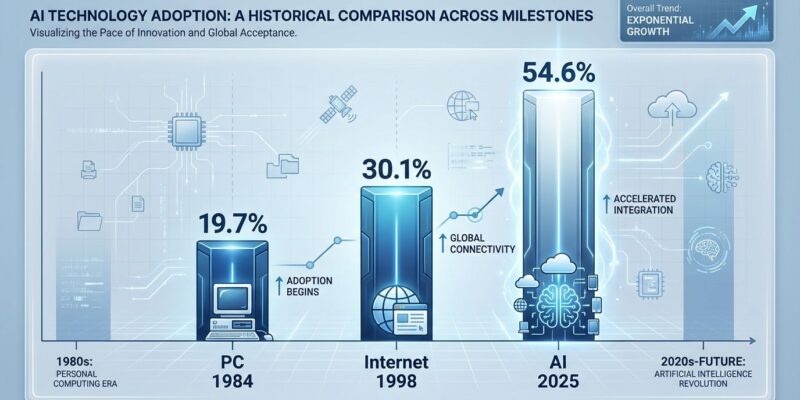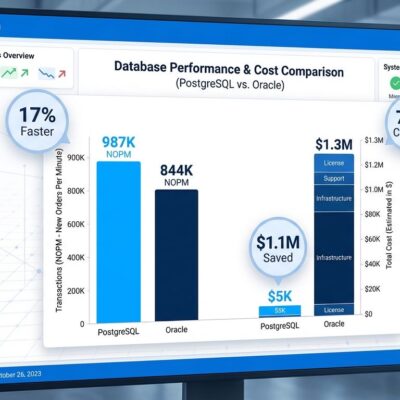
Generative AI adoption reached 54.6% among U.S. adults in August 2025—nearly triple the personal computer adoption rate in 1984 (19.7%) and almost double the internet adoption rate in 1998 (30.1%), both measured at the same three-year mark from mass availability. Federal Reserve Bank of St. Louis research published November 13, 2025 shows 171 million Americans now use ChatGPT, Claude, Copilot, or similar AI tools for work or personal tasks. This 10 percentage point year-over-year jump from 44.6% in August 2024 makes AI the fastest-adopted consumer technology in modern history—2.8 times faster than PCs and 1.8 times faster than the internet at equivalent stages.
Why AI Adoption is Faster: The Infrastructure Advantage
AI achieves unprecedented adoption speed because it eliminates the barriers that slowed previous technology waves. Personal computers in 1984 required a $2,000+ hardware purchase (equivalent to $5,800 today). The internet in 1998 demanded ISP subscriptions, modem hardware, and technical configuration knowledge. AI tools in 2025 require opening a web browser.
Federal Reserve economists explain the mechanism: “Generative AI is built on top of those previous two technologies. You could think about the fact that people have computers in their home, and they have access to the internet, as base layers that allow you to easily adopt some new technology like generative AI.” This infrastructure advantage creates zero marginal cost for new users—no purchase decision, no setup friction, no technical knowledge barrier.
The adoption curve reflects this reality. ChatGPT reached 1 million users in five days, hit 100 million monthly active users by January 2023 (two months post-launch), and now serves 800 million weekly users as of November 2025. No consumer technology in history has scaled this fast. TikTok previously held the “fastest to 100 million” record at nine months—ChatGPT beat it by seven months.
The Developer Productivity Paradox
Adoption numbers tell only half the story. Federal Reserve research claims AI delivers 1.6% work hour savings and a potential 1.3% labor productivity increase since ChatGPT’s launch. However, a randomized controlled trial by METR studying 16 experienced open-source developers reveals AI made them 19% slower on complex repository tasks—despite developers believing AI made them 20% faster.
This perception-reality gap exposes the limitations of self-reported productivity metrics. METR researchers assigned 246 real repository issues (bug fixes, features, refactors) to developers working with and without AI access. Developers using Cursor Pro with Claude 3.7 Sonnet took 19% longer to complete tasks while maintaining the same code quality. Before the study, they predicted a 24% speedup. After experiencing slower completion times, they still believed AI saved them 20%. Their feelings contradicted objective measurement.
The contradiction resolves when you examine task complexity. Controlled enterprise studies show AI delivers 20-30% speedups on well-defined, repetitive tasks like boilerplate code generation or documentation. Complex problem-solving requiring deep context and architectural understanding shows the opposite pattern. Organizational data confirms the tension: teams with high AI adoption see 91% longer pull request review times and 9% more bugs per developer, according to the Faros AI Productivity Paradox Report.
Workplace AI Adoption Makes Literacy Career-Critical
With 37.4% of U.S. workers (59 million people) now using AI at work, tool proficiency has shifted from competitive advantage to baseline expectation. The tech sector leads at 88% adoption, followed by professional services (80%), media and telecom (79%), and healthcare (63%). Marketing and sales teams show the highest functional adoption at 42%, indicating AI’s reach extends beyond technical roles.
Adoption intensity matters more than raw percentages. The share of work hours spent using AI jumped from 4.1% to 5.7% between November 2024 and August 2025—a 39% increase in just nine months. Workers aren’t just trying AI once; they’re integrating it into daily workflows. For developers in tech companies with 88% adoption rates, avoiding AI tools means falling behind peers who leverage them for boilerplate generation and documentation.
However, the career calculus cuts both ways. While 37.4% workplace adoption suggests AI literacy is now required, the METR study showing 19% slowdowns on complex tasks reveals that over-reliance creates risk. Developers who can’t debug AI-generated code—45% say debugging AI output takes longer than writing from scratch—lack the fundamentals required for complex problem-solving. The optimal strategy: use AI for repetitive tasks while maintaining deep technical skills for architecture and debugging.
The 45.4% Who Aren’t Adopting: Resistance or Wisdom?
While 54.6% adoption dominates headlines, 143 million U.S. adults (45.4%) haven’t used AI tools despite free availability and sustained media coverage. This non-adoption may reflect rational skepticism rather than missing out. Research suggests adoption will plateau at 65-75%—closer to social media (70%) than smartphones (85%+)—as remaining non-adopters resist due to privacy concerns, demonstrated productivity limitations, or jobs where AI adds marginal value.
Enterprise adoption data supports this interpretation. McKinsey research shows 80% of organizations explored AI tools, but only 40% deployed them, and just 5% reached production with measurable profit-and-loss impact. That’s a 95% pilot failure rate. Deloitte’s analysis reveals similar patterns: 60% evaluated enterprise-grade systems, 20% reached pilot stage, and 5% achieved revenue acceleration. The gap between interest and value creation suggests adoption doesn’t guarantee productivity gains.
For developers, the 45.4% non-adoption rate validates tactical AI use over total adoption. Given that METR’s study showed negative productivity for experienced developers on complex work, and 95% of enterprise pilots fail to deliver business value, skepticism about AI’s transformative potential is data-supported. The market appears to be self-correcting as users discover AI’s strengths (simple, repetitive tasks) and limitations (complex problem-solving requiring judgment). Adoption for the sake of adoption—driven by FOMO rather than demonstrated value—leads to the productivity paradox where individuals write more code but organizations ship slower.
Key Takeaways
- AI adoption (54.6%) is 2-3x faster than PCs (19.7%) and internet (30.1%) at the same three-year stage because it’s built on existing infrastructure—no hardware purchase, no ISP setup, just a web browser. ChatGPT reached 100 million users in two months compared to years for previous technologies, demonstrating zero-friction adoption at scale.
- Workplace adoption (37.4%) makes AI literacy career-critical for developers, especially in tech (88% adoption), but complex problem-solving skills remain more valuable than AI tool proficiency. Work hour intensity using AI jumped 39% in nine months (4.1% to 5.7%), indicating sustained integration beyond experimentation.
- Productivity claims require skepticism: Federal Reserve reports 1.3% gains based on self-reported data, while objective measurement shows 19% slowdown on complex tasks. The paradox resolves by task type—AI accelerates boilerplate (20-30% faster) but slows architectural work and debugging. Trust data over perception.
- 45.4% non-adoption may reflect rational skepticism given 95% enterprise pilot failures and negative productivity on complex work. Adoption will likely plateau at 65-75% as market segments into high-value use cases (code generation, documentation) versus resistant areas (complex problem-solving, quality-critical work requiring deep context).
- Optimal developer strategy: tactical AI adoption for repetitive tasks while maintaining fundamental skills for architecture and debugging. Avoid over-reliance that creates dependency on AI-generated code that “almost works but not quite” (66% cite as biggest frustration). Measure end-to-end delivery time, not code generation speed.












